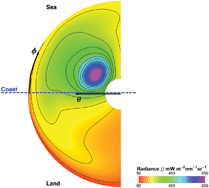Spectral UV radiance measured at a coastal site: a case study
Abstract
We have sampled the spatial distribution of the UV radiation (i.e. the UV radiance) at a station located on the southern pacific coastline (Valparaiso, Chile, 33.03°S–71.58°W). The site is characterized by the partial horizon obstruction (due to the surrounding topography). Our spectral measurements were carried out over the period January–March 2012 and were meant to weigh up the effects of the local cloudiness, the heterogeneous albedo, and the horizon obscuration. We found that a nearly translucent overcast sky affects the radiance distribution such that from its maximum (measured close to the solar zenith angle) the radiance is monotonically decreasing towards the horizon. Under cloudless conditions, the radiance distribution becomes less isotropic with the wavelength; we detected spatial variations in the distribution of radiation up to a factor of 5 at 320 nm, and up to a factor of 9 at 400 nm. We also observed that radiances measured at points over the sea are greater than those measured at the corresponding point over the land; we partially attributed this effect to the spatial variations in the albedo. Moreover, we found that the horizon obscuration leads to significant reductions in the radiance at points on the blocked horizon; these reductions range from 60% (at 400 nm) to 80% (at 300 nm). Methodological details are provided below.


 Please wait while we load your content...
Please wait while we load your content...